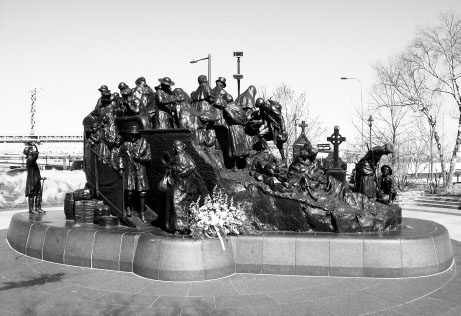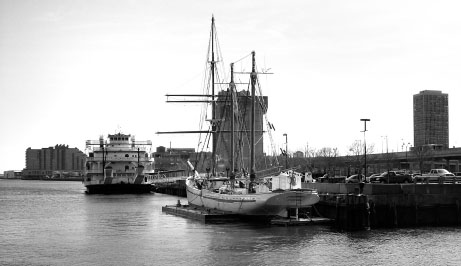Philadelphia's Lost Waterfront (24 page)
Read Philadelphia's Lost Waterfront Online
Authors: Harry Kyriakodis
The rough-and-tumble dock area along Delaware Avenue was slowly transformed into an appealing place for Philadelphians and tourists to pursue leisure activities as Penn's Landing evolved into Philadelphia's premier multi-use riverside park. At the same time, sailboats and cruise ships supplanted tugboats and cargo ships in plying the Delaware.
In the 1980s, the City of Philadelphia built the Great Plaza at Penn's Landing, a public amphitheater at the bottom of Chestnut Street. Together, it and Festival Pier at Spring Garden Street provide a venue for various free and fee-based festivals, performances and other events. Fireworks are routinely presented on the Delaware, and a seasonal ice-skating rink, the Blue Cross RiverRink, is often jam-packed. What's more, the Penn's Landing Marina supports kayak and swan boat rentals. All these activities on the Philadelphia waterfront would have been deemed preposterous as recently as 1970.
The periodic pyrotechnics at Penn's Landing bring to mind the fireworks display that Captain John André organized in 1778 for the Mischianza. Plus, the outdoor skating rink is reminiscent of the era when ice skaters twirled atop the frozen Delaware.
F
AILURES TO
L
AUNCH
Enhancements to Penn's Landing have been planned for decades, but all have been shelved for one reason or another. The first proposal was in 1973 for a complex of office and apartment towers. Several grandiose schemes have been offered and withdrawn since then. The most recent serious plan, a $200 million Family Entertainment Center, would have had retail shops, restaurants, a three-thousand-seat amphitheater, two ice-skating rinks and a fifteen-screen movie theater. Proposed by Simon DeBartolo Group, it was dropped in 2002 after five years of talk.
The canyon of Interstate 95 paralleling Penn's Landing is what has doomed all of this possible redevelopment. The Delaware Expressway will continue to stifle the central waterfront of Philadelphia for a very long time. With its six lanes of traffic and Belt Line tracks, Columbus Boulevard does not help matters.
A bridge at Market Street helps provide access to the Delaware River from Old City Philadelphia. This high viaduct crosses over both I-95 and Columbus Boulevard and then loops to Chestnut Street. Its excessive height was dictated by the need to clear the partially elevated highway. Two ungainly vehicular ramps (the “scissor ramps”) lead from Columbus Boulevard up to Market Street and from Chestnut Street down to Columbus Boulevard.
A drab flight of concrete steps at the end of Market Street connects the viaduct to the waterfront's lower level, providing pedestrians a way to get to Penn's Landing. This tall, spindly stairway can be deemed a contemporary successor to the bank steps of William Penn.
Penn Praxis's thirty-year plan for the Philadelphia riverfront calls for all parking lots and other unsightly hardscape at Penn's Landing to be turned into green space. Whether any of this will ever happen is uncertain.
T
HE
S
KYLINK
A
ERIAL
T
RAM AND THE
“K
EYSTONE
S
TATE
A
RCH
”
The strange concrete arch by the river between Market and Chestnut Streets is the tower support for the Skylink Aerial Tram, a never-completed ski liftâtype ride to Camden. Gondolas were intended to have whisked as many as two thousand people an hour across the river at this point.
The Delaware River Port Authority spent some $13 million building the tower structure and its counterpart in Camden before work ceased in 2003. Controversy had erupted over whether the Skylink was a transit project or a tourist attraction and whether toll money from local Delaware River crossings should be used to construct it. The tram's tower support was left standing in the wake as a stark example of conflict relating to activity by the water and the riverfront's overall use and enjoyment.
One proposal is to make the Ï-shaped support a state memorial to commemorate Pennsylvania's founding not far from that locale. The monolithic structure would be named the Keystone State Arch.
T
HE
I
RISH
M
EMORIAL
A proper memorial is already located at Front and Chestnut Streets: the Irish Memorial. This striking bronze sculpture-in-the round brings to life the story of An Gorta Mór (the Great Hunger) and pays respect to the Irish men, women and children who perished during the famine between 1845 and 1850 caused by potato blight. It also celebrates the millions of Irish immigrants who came to the United States seeking a better life. Crafted by eminent sculptor Glenna Goodacre, the work was dedicated on October 25, 2003.
The 1.75-acre memorial grounds are on top of one of the covers above Interstate 95. This high vantage point overlooks the Delaware River and is a fitting location for the monument because countless Irish disembarked ships and entered Philadelphia (and the nation) along the riverfront on either side of that location. Unfortunately, as with Foglietta Plaza and the Vietnam Veterans Memorial, the ever-present sound of vehicles on I-95 ruins what is meant to be a contemplative place.

The Irish Memorial, installed in 2003 at Front and Chestnut Streets on one of the two covers atop I-95.
Photo by the author
.
I
NDEPENDENCE
S
EAPORT
M
USEUM
Independence Seaport Museum (ISP) at Penn's Landing explores the role that the Port of Philadelphia has played regionally and nationally in trade, immigration, defense and recreation. It features interactive exhibits and over ten thousand maritime artifacts, including navigational instruments, naval uniforms and model ships.
State-of-the-art exhibits make this museum the preeminent facility for preserving and sharing the maritime tradition of the Delaware River and Bay. The centerpiece attraction, Home Port: Philadelphia, explores the city's waterfront activities over time. Immigrant stories are shared at a re-creation of the Washington Avenue Immigration Station. A Navy Yard exhibit highlights the life of a longshoreman. The Workshop on the Water shows the skills and heritage of wooden boat building and sailing on the Delaware.
The Historic Ship Zone includes the USS
Becuna
(SS-319), a World War II submarine that gives visitors the chance to glimpse the lives of members of the nation's “silent service.” Few World War II subs are on display in America, and this is one of them. The Balao-cless vessel was commissioned in May 1944 as the submarine flagship of the Southwest Pacific Fleet under General Douglas MacArthur. Very active during the war, the
Becuna
was awarded four Battle Stars and a Presidential Unit Citation for its efforts.
ISP's true star, however, isâor wasâthe naval cruiser USS
Olympia
. A National Historic Landmark, the
Olympia
was Admiral George Dewey's flagship in the Spanish-American War and is the sole surviving ship from that contest. After decommissioning in the early 1920s, the
Olympia
went to the Philadelphia Naval Yard, where it stayed for over thirty years before the Cruiser Olympia Association moved it to the foot of Race Street in 1958. It opened there as a museum before being moved to Penn's Landing. As of 2011, the vessel's fate is in jeopardy: the
Olympia
is set to be disposed of because its hull is rusting badly.
It's too bad that Philadelphia has lost its shipbuilding and repair expertise. Any one of several regional shipyards in operation decades ago could have restored the
Olympia
, the Philadelphia Navy Yard being the likeliest. But sadly, even that facility closed in 1996. (A small commercial shipyard is, however, now operating at the Navy Yard site.)
Independence Seaport Museum is housed in the old Port of History Museum building, built by the Commonwealth of Pennsylvania for the U.S. Bicentennial. Finished a bit late in 1977, the edifice had a rocky financial and political start and sat empty for years. The “white elephant” on the riverbank was taken over by the Philadelphia Maritime Museum, which changed its name when the place reopened in 1995.
G
AZELA
AND
J
UPITER
Penn's Landing is homeport to the
Gazela
, the world's oldest and largest wooden square-rigged barkentine still sailing. Dating back to 1883, the vessel is owned and operated by the Philadelphia Ship Preservation Guild. The Philadelphia Maritime Museum brought it to Philadelphia in 1971 to represent the city in the U.S. Bicentennial's Tall Ships Parade in New York Harbor. The
Gazela
has been promoting the City of Brotherly Love ever since, sailing to ports around the nation and the world. In this way, the ship acts as Philadelphia's goodwill ambassador and carries on the city's long maritime tradition.

The
Gazela
and
Philadelphia Belle
docked at Penn's Landing, an area once filled with piers.
Right
: One of the Society Hill Towers.
Distant left
: the Dockside condominium.
Center
: The Independence Seaport Museum and the Skylink Aerial Tram's tower support (behind the
Gazela
).
The Ship Preservation Guild also owns and operates the tugboat
Jupiter
. Built in 1902 at the Philadelphia shipyard of Neafie & Levy, this is the oldest continually operating tug on the Delaware River. The tug was bought by the Independent Pier Company of Philadelphia in 1939 after having worked in New York Harbor as the
Sacony #14
. Renamed
Jupiter
, it helped launch naval vessels from shipyards on the Delaware during the Second World War and continued working commercially until the Guild acquired it in 1989.
The
Jupiter
is still a functioning tug but it also participates in educational programs, festivals and even boat parades. The occasional flotillas on the Delaware are not all that different from the procession of bedecked barges that transported guests to the Mischianza in 1778.
M
OSHULU
Another exceptional ship at Penn's Landing is the
Moshulu
, a 394-foot steel clipper that is the world's oldest and largest four-masted sailing ship. This vessel's story is too convoluted to summarize here, but a short account of its tumultuous time in Philadelphia is in order.
The
Moshulu
was purchased for use as a floating restaurant in the 1970s. It was towed across the Atlantic first to New York City and then to Philadelphia. While serving as an exotic eatery at Penn's Landing, a four-alarm fire broke out in the galley in 1989. Fire and smoke/water damage closed the restaurant for years. While the
Moshulu
languished, it was vandalized and stripped of much of its gear. But in 1995, the ship was purchased by H.M.S. Ventures and underwent an $11 million restoration.
Misfortune struck again in 2000 when Pier 34 Southâwhere the
Moshulu
was then dockedâcollapsed into the Delaware River. The ship closed at that point. Two years later, it was moved to the Penn's Landing Marina and shortly reopened as a South Seas restaurant.
T
RAGEDY ON THE
W
ATER
: P
IER
34 S
OUTH
, R
IDE THE
D
UCKS AND THE
F
ERRYBOAT
N
EW
J
ERSEY
The collapse of Pier 34 occurred in the evening of May 18, 2000. The far section of the pier suddenly fell into the Delaware, killing three women and injuring dozens others. They were all partying at Club Heat, an outdoor nightclub at the end of the dock, then called Eli's Pier 34. Darkness, debris and river currents hampered rescue efforts, as did the threat of the rest of the pier's collapse.
The owner of Pier 34 and the manager of the club were ultimately charged for failure to maintain and repair the wharf's foundation, even after weeks of visible warnings that the deck was shifting. They both pleaded guilty and were sentenced to community service and a year of house arrest. The Reading Railroad had built the pier in 1909 for use in loading coal onto ships.